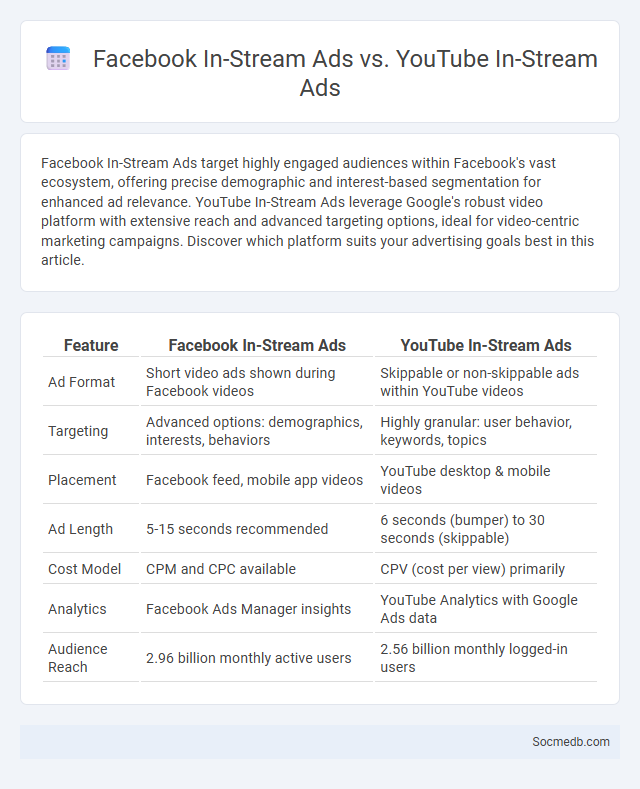
Photo illustration: Facebook In-Stream Ads vs YouTube In-Stream Ads
Facebook In-Stream Ads target highly engaged audiences within Facebook's vast ecosystem, offering precise demographic and interest-based segmentation for enhanced ad relevance. YouTube In-Stream Ads leverage Google's robust video platform with extensive reach and advanced targeting options, ideal for video-centric marketing campaigns. Discover which platform suits your advertising goals best in this article.
Table of Comparison
| Feature | Facebook In-Stream Ads | YouTube In-Stream Ads |
|---|---|---|
| Ad Format | Short video ads shown during Facebook videos | Skippable or non-skippable ads within YouTube videos |
| Targeting | Advanced options: demographics, interests, behaviors | Highly granular: user behavior, keywords, topics |
| Placement | Facebook feed, mobile app videos | YouTube desktop & mobile videos |
| Ad Length | 5-15 seconds recommended | 6 seconds (bumper) to 30 seconds (skippable) |
| Cost Model | CPM and CPC available | CPV (cost per view) primarily |
| Analytics | Facebook Ads Manager insights | YouTube Analytics with Google Ads data |
| Audience Reach | 2.96 billion monthly active users | 2.56 billion monthly logged-in users |
Overview of Facebook In-Stream Ads
Facebook In-Stream Ads appear within video content, providing targeted advertising that reaches users during natural viewing experiences. These ads enhance engagement by appearing to viewers who have already opted to watch content, increasing relevance and ad recall. Your brand can leverage Facebook's advanced targeting options to deliver personalized messages directly to specific audience segments within video streams.
Introduction to YouTube In-Stream Ads
YouTube In-Stream Ads are video advertisements that play before, during, or after other videos on YouTube, providing a targeted way to reach your audience. These ads can be skippable or non-skippable, allowing advertisers to engage viewers with compelling content while maximizing brand visibility. Leveraging YouTube's vast user base and advanced targeting options, you can optimize your campaign for higher engagement and conversion rates.
Key Features and Formats: Facebook vs YouTube
Facebook offers diverse content formats including text posts, images, videos, Stories, and live streaming, with advanced targeting options for advertising and interactive features like groups and events. YouTube specializes in video content, supporting various formats such as short-form Shorts, long-form videos, playlists, live streams, and Premieres, emphasizing video monetization through ads and channel memberships. Both platforms prioritize user engagement through algorithms that tailor content feeds based on user behavior and preferences.
Monetization Models Comparison
Social media platforms utilize diverse monetization models including advertising revenue, subscription services, and in-app purchases to generate income. Advertising models leverage targeted ads based on user data, offering the highest revenue potential across platforms like Facebook, Instagram, and TikTok. Subscription and premium content models, seen in platforms such as YouTube Premium and Twitter Blue, provide steady income by offering exclusive features or ad-free experiences to paying users.
Audience Targeting Capabilities
Social media platforms offer advanced audience targeting capabilities that allow you to precisely reach users based on demographics, interests, behaviors, and location. Leveraging data analytics and machine learning, advertisers can create highly personalized campaigns that improve engagement and conversion rates. These tools enable efficient budget allocation by focusing on users most likely to respond positively to your content.
Ad Placement and Reach Analysis
Effective ad placement on social media leverages user data to target specific demographics, enhancing the visibility of your campaigns across platforms like Facebook, Instagram, and Twitter. Reach analysis tools track engagement metrics such as impressions, clicks, and conversion rates, providing insights that optimize ad performance and budget allocation. Maximizing your ad reach through precise placement and ongoing analysis ensures higher ROI and better audience connection.
Revenue Potential and Payout Rates
Social media platforms offer significant revenue potential through diverse monetization avenues such as advertising, sponsored posts, and affiliate marketing, with payout rates varying based on user engagement and platform policies. High-traffic profiles and niche content creators typically command more lucrative deals, reflecting their ability to drive targeted audience actions. Understanding these dynamics helps optimize your social media strategy to maximize earnings and improve payout rates effectively.
Engagement Metrics and Performance Insights
Engagement metrics such as likes, comments, shares, and click-through rates provide crucial data to evaluate the effectiveness of your social media campaigns. Performance insights drawn from these metrics help you understand audience behavior, optimize content strategies, and maximize reach. Tracking follower growth and post engagement over time enhances your ability to tailor content that resonates with your target market.
Pros and Cons for Creators
Social media platforms offer creators unprecedented opportunities for audience growth, brand building, and direct monetization through tools like sponsored content and fan subscriptions. However, creators face challenges such as algorithm dependency, content oversaturation, and mental health risks stemming from constant public scrutiny and online harassment. Balancing creative freedom with platform demands is essential for sustained success and well-being in the digital creator economy.
Choosing the Best Platform for Video Monetization
Selecting the optimal platform for video monetization depends on factors such as audience demographics, content type, and revenue models available. YouTube remains a leading choice thanks to its vast user base, diverse monetization options like ad revenue and channel memberships, and advanced analytics tools. TikTok and Instagram are rapidly growing alternatives that offer unique monetization features through brand partnerships, sponsored content, and creator funds, making them ideal for short-form video creators targeting younger audiences.
 socmedb.com
socmedb.com